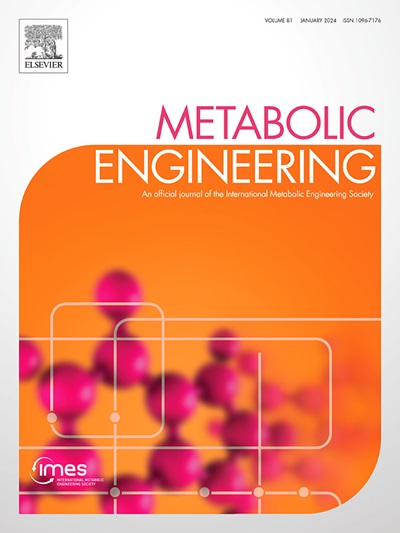实验室和益生菌酵母的多层生物防护系统。
IF 6.8
1区 生物学
Q1 BIOTECHNOLOGY & APPLIED MICROBIOLOGY
引用次数: 0
摘要
将基因工程微生物限制在指定的活动环境中,是防止其向自然界扩散的重要步骤。传统上采用物理屏障来解决这一问题,然而,在开放动态环境中越来越多的生物技术操作要求内在的生物遏制。在这里,我们描述了遗传嵌入式保护系统的发展,这两个实验室菌株酿酒酵母和商业益生菌酿酒酵母变种博氏。在逐步的方法中,在它们组合成正交的双输入系统之前,开发了基于合成缺陷或基于crispr的终止开关的单输入代谢电路。所有电路都是基于肠道活性分子或环境线索,使它们适用于微生物组治疗应用。在限制性条件下孵育至少6天后,最终的双输入系统在超过100代的情况下是稳定的,同时在109个cfu中实现少于一个逃逸。在允许的条件下,含生物菌株可以稳定地产生异源蛋白,支持它们未来在各种应用中的应用,如原位生产和递送具有药物活性的代谢物。本文章由计算机程序翻译,如有差异,请以英文原文为准。

A multilayered biocontainment system for laboratory and probiotic yeast
The containment of genetically engineered microorganisms to designated environments of action is a paramount step in preventing their spread to nature. Physical barriers were traditionally employed to solve this issue, nevertheless, the growing number of biotechnological operations in open dynamic environments calls for intrinsic biocontainment. Here we describe the development of genetically embedded safeguard systems for both a laboratory strain of Saccharomyces cerevisiae and the commercial probiotic Saccharomyces cerevisiae var. boulardii. In a stepwise approach, single-input metabolic circuits based either on a synthetic auxotrophy or a CRISPR-based kill switch were developed before their combination into an orthogonal two-input system. All circuits are based on gut-active molecules or environmental cues, making them amenable to microbiome therapy applications. The final two-input system is stable for more than a hundred generations while achieving less than one escapee in 109 CFUs after incubation under restrictive conditions for at least six days. Biocontained strains can robustly produce heterologous proteins under permissive conditions, supporting their future use in the most varied applications, like in-situ production and delivery of pharmaceutically active metabolites.
求助全文
通过发布文献求助,成功后即可免费获取论文全文。
去求助
来源期刊

Metabolic engineering
工程技术-生物工程与应用微生物
CiteScore
15.60
自引率
6.00%
发文量
140
审稿时长
44 days
期刊介绍:
Metabolic Engineering (MBE) is a journal that focuses on publishing original research papers on the directed modulation of metabolic pathways for metabolite overproduction or the enhancement of cellular properties. It welcomes papers that describe the engineering of native pathways and the synthesis of heterologous pathways to convert microorganisms into microbial cell factories. The journal covers experimental, computational, and modeling approaches for understanding metabolic pathways and manipulating them through genetic, media, or environmental means. Effective exploration of metabolic pathways necessitates the use of molecular biology and biochemistry methods, as well as engineering techniques for modeling and data analysis. MBE serves as a platform for interdisciplinary research in fields such as biochemistry, molecular biology, applied microbiology, cellular physiology, cellular nutrition in health and disease, and biochemical engineering. The journal publishes various types of papers, including original research papers and review papers. It is indexed and abstracted in databases such as Scopus, Embase, EMBiology, Current Contents - Life Sciences and Clinical Medicine, Science Citation Index, PubMed/Medline, CAS and Biotechnology Citation Index.
 求助内容:
求助内容: 应助结果提醒方式:
应助结果提醒方式:


